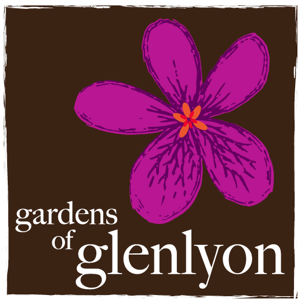Dee and Tony grew up in Yorkshire, a world away from their current home in Glenlyon, in the central highlands of Victoria. They have lived in many places, including the West Indies, and each place has influenced their views on gardens and gardening.
 |
| Dee exploring Musk Farm |
As a small girl, Dee used to help her father in the garden. Wielding a pair of scissors in her tiny hands, she would assist by cutting the grass away from the base of the apple tree. She learned about growing plants by observing the seedlings that grew in her father's glass frame. But the seedling frame holds some intriguing memories- the splintering of glass if she should fall, for instance. Or the image of wriggling little maggots that grew out of the contraband ham, bought by her mother on the black market (these were the war years) and quickly buried when an inspector came visiting.
An important part of Dee's early education about gardens was provided through visits with her parents to some of the great English gardens. For Tony, the war years and frequent moves by his family precluded any involvement with gardens or gardening.
In the early years of their marriage in England, Dee notes that they "were too sophisticated and urban to garden". Their attempts at gardening involved "trying to tidy up the mess" of other people's gardens, as they moved from place to place. The new house in York, for example, was "just a patch of mud", to which Dee added a beautiful clematis. Or the house located in the grounds of H.G. Wells' property, with steep slopes of exposed clay and masses of roses, a challenge that was too confronting. An exception was Hope Cottage, which, although very wild, was a wonderful garden, tied up in parts with the previous owners' lisle stockings.
Following a stay in Trinidad, where they were surrounded by the exotic and sweet-smelling plants of the tropics, Dee and Tony migrated to Sydney and then to a place in Melbourne. This was their first opportunity to 'settle'. However, they confronted the challenge of once more taking over a mess, but this time transforming it. "When we moved in" said Tony, "there was a ten foot pile of rubbish, a red shed and a Mini Minor".
Melbourne was an entirely different place in which to garden, with its depleted soils, sudden weather changes, droughts and high winds. With the assistance and advice of friends, one an architect and the other a landscape designer, Dee set about formally designing a garden. Jan, her next door neighbour, provided her with invaluable advice about plants.
An existing apricot tree and a stand of bamboo formed the background to the evolving garden, to which was added formal brick paths and banks of flowering plants. The wasteland became a lush haven, but eventually, for these world travellers, it was time to move on. Following a brief time in Mirranatwa, they took over a horse paddock in Glenlyon.
 |
| The birth of a garden: Doll's Paddock |
Following the building of their strawbale home, the development of the garden at Glenlyon required the transformation of a naked building site. The house was 'floating' in the middle of bare earth, disconnected with the surrounding landscape of golden paddocks and the river valley beyond. A low stone wall was erected to frame the house, the slope to the river was modified, and the outlet pipe down the slope provided the source of a notional waterfall. Since then, masses of trees have been planted, including stands of crab apples and silver birches. At the base of the rill, whispering allocasuarinas form an oasis.
 |
| Planning on the rill |
 |
| Containing with a low wall |
 |
| Listening to nature: drought tolerant plants |
Dee has a great eye for colour, form, shape and perspective. Drawing on her knowledge of the great English gardens, observation and endless conversations with informed friends (in particular Classics scholar and landscaper Ray Robinson), she and Tony have created a vibrant garden that sits comfortably in its rural Australian setting. Importantly, they closely observe the cyclical nature of weather patterns and respond to the wordless messages that the plants provide, for as Dee explains, "nature itself tells you what is to happen".
 |


hello dee
ReplyDelete